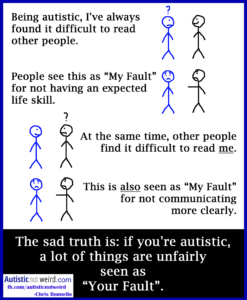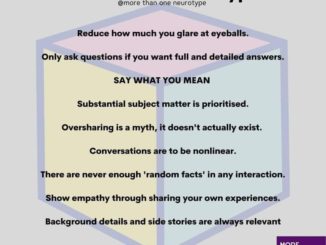There is a common misconception that people with autism don’t show empathy, or don’t feel empathy, or cannot take on the perspective of someone else.
The three categories given in the DSM-5 definition of autism, all of which are required to be met in order for a person to receive that diagnosis, cover (1) social-emotional reciprocity, (2) nonverbal communication, and (3) relationships. The DSM criteria focus on the ways in which autistic people differ from neurotypical people in those three categories. All of which, to some extent, can be categorized as forms of empathy or empathic communication.
But to hear Autistic people speak about themselves, they are actually deeply empathetic. Often, it’s more likely that they just aren’t expressing their empathy in a way that neurotypicals recognize, accept, or acknowledge as being empathy. In fact, many Autistic people feel that they might have a stronger, more intense empathy for others than neurotypical people feel or express, because of the intensity of emotion and sensation that often accompanies autism.
Alternately, they might feel empathy more strongly with animals, plants, inanimate objects, on a level that they don’t feel with human beings — which could be partially innate, or could be due to trauma (i.e., used to being rejected by other people, which doesn’t happen with animals, for instance).
Lots of assessments and interventions in autism, especially in early childhood, are aimed at trying to teach or impart empathy — empathy as it would appear to a neurotypical person. Therapists or teachers may use exaggerated emotions when interacting with kids with autism, or put on displays with puppets or dolls, and may grow frustrated or dismissive when autistic kids don’t learn to respond to these displays in a neurotypical way.
A growing theory, the “double empathy problem” (articulated by Damian Milton), suggests that Autistic people have a hard time understanding and therefore expressing empathy for non-autistic (allistic) people in a way that allistic people understand — but so, too, do allistic people have the exact same problem in reverse.
It’s just that society at large expects neurotypical people to be the default, and so Autistics’ difference in communication is instead categorized as a disorder, whereas allistics’ difference in communication back toward autistics is seen as the norm.
Another component of this is that “empathy” isn’t a singular thing. The component of empathy that deals with being able to estimate somebody else’s emotional response to something is the “empathy” between autistics and allistics that is the biggest barrier. But the desire to help others who are hurting, or the desire to connect with others, and the ability to feel emotions deeply, are all present in people with autism — again, sometimes to an even higher degree than in neurotypical people.
If you feel like delving much further into this, this is a really intriguing article.
The linked image, a comic from Autistic Not Weird, puts it extremely succinctly. Autistic people are seen as being “at fault” for not seeming empathetic, or not communicating in expected ways. Yet when non-autistic people misunderstand *them* and their emotional cues, they are again seen as being “at fault”…for not expressing emotional cues in non-autistic ways. Instead, it’s more likely that both cultures just struggle to understand the expressions within one another. But put an Autistic person in a community of other Autistic people, and they empathize — and express it — just fine, in ways that are immediately understood by others from within their “culture”.

[Image description:
A stick-figure comic in blue and black.
The first part reads, “Being autistic, I’ve always found it difficult to read other people.” The picture has two characters looking at one another, and the blue one has a question mark over their head.
The second part reads, “People see this as ‘my fault’ for not having an expected life skill.” The stick figure drawn in black is pointing with an angry face, accusingly, at the blue figure, who looks confused and sad.
The third part reads, “At the same time, other people find it difficult to read me.” The stick figure drawn in black now has the question mark over their head.
The fourth part reads, “This is *also* seen as ‘my fault’ for not communicating more clearly.” The stick figure drawn in black is pointing with an angry, accusing face again.
The bottom text reads, “The sad truth is: if you’re autistic, a lot of things are unfairly seen as ‘your fault’.” The author’s tag, Autistic Not Weird, is also on the image. End description.]


